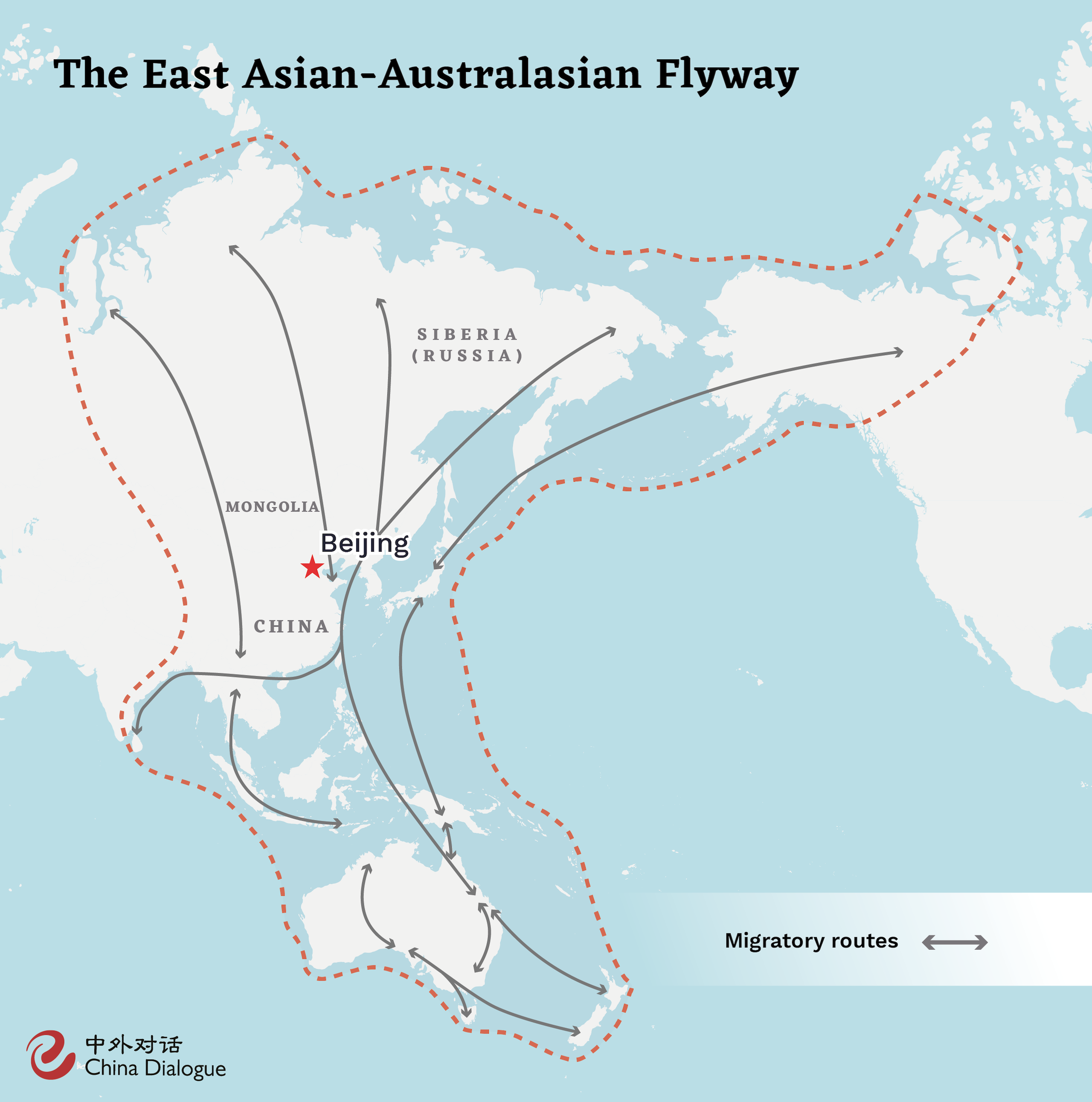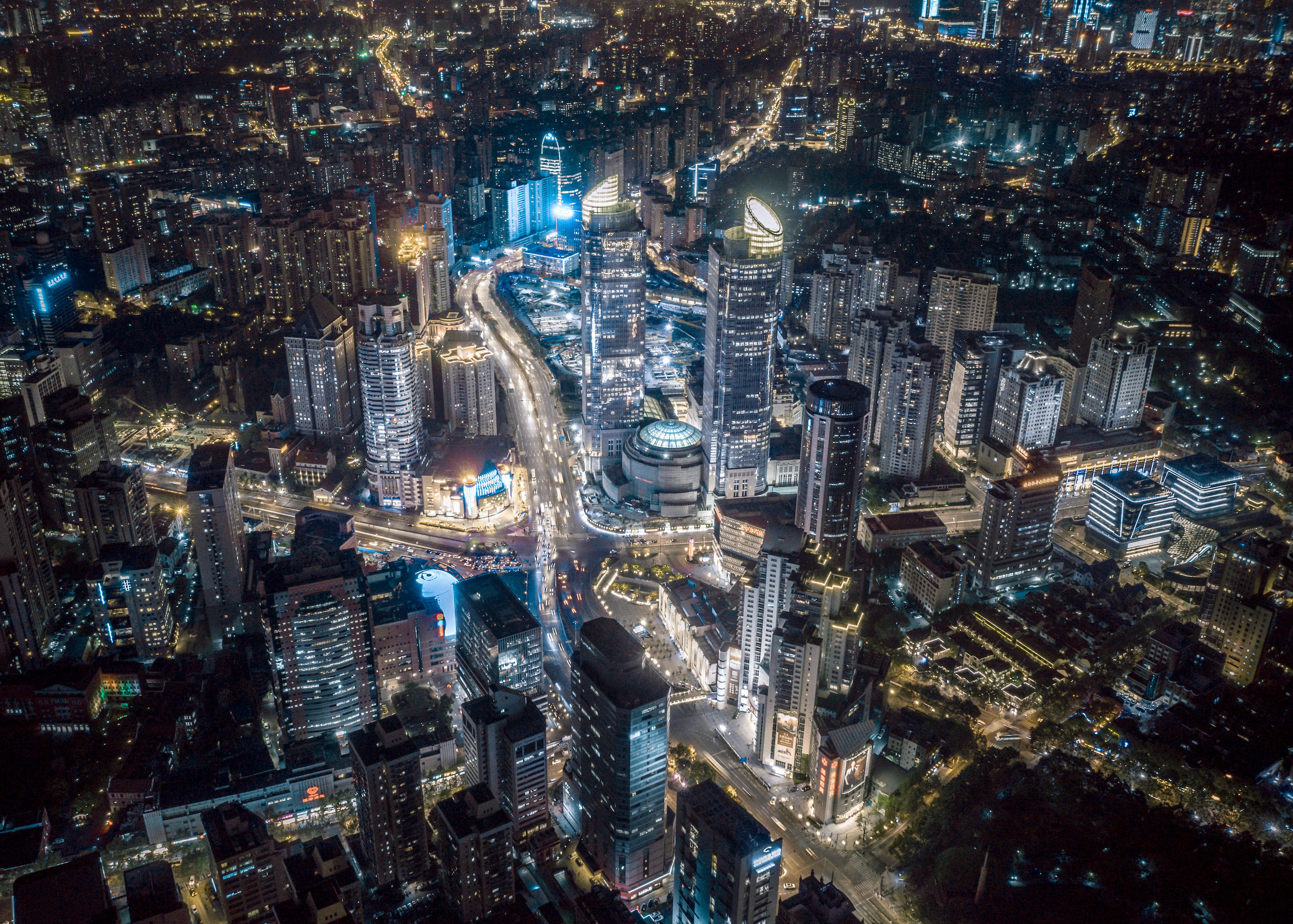Shanghai has become the first place in China to implement rules on light pollution.
New language on light pollution in the city’s environmental protection regulations came into effect in August. The rules refer to “the needs of ecological and environmental protection”, but the articles only cover the impact of light pollution on residents and traffic safety, saying that light sources should not directly illuminate homes or distract drivers. There are no regulations designed to protect wildlife.
But light pollution does negatively affects wildlife, particularly migratory birds. “Dim the Lights for Birds at Night” was the theme of this year’s Migratory Bird Day.
Places around the world are increasingly using lighting guidelines and policies to reduce the harm to wildlife. China is off to a late start. International experience shows it is vital to increase public awareness and use data and scientific research to encourage policy change.
Light pollution and migratory birds
Urbanisation and industrialisation have made light pollution a global problem – and one that is getting worse. Researchers from the University of Essex examined light emissions from 1992 to 2017 and found they had increased globally by 49% in those 25 years. That only covers light detected by satellites. The true figure could be up to 270%, they say.
In China, associate researcher Liu Chengze and others at Shanghai Jiaotong University’s School of Physics and Astronomy conducted a similar study on light pollution in Shanghai. They found that at night, the central district of Xujiahui is 25 times as bright as Nanhuizui on the city’s outskirts. Background light levels at the observatory on Sheshan, Shanghai’s only mountain, increased by 170 times between 1994 and 2011.
Light is essential to organisms as a source of energy and information. Animals use it, including moonlight and starlight, to gather information about their environment, to navigate and to hunt. Excessive artificial illumination disrupts their natural day–night cycle and changes breeding and migratory behaviours.
For decades, researchers have been demonstrating the impact of artificial light on animal biology and behaviour. Their findings have brought about some changes.
In 2020, signatories to the UN Convention on the Conservation of Migratory Species of Wild Animals passed guidelines on light pollution and wildlife, covering turtles, seabirds and migratory shorebirds. The guidelines include six principles for best lighting design practice and suggest environmental impact assessments for any undertaking that may cause light pollution. Signatories to the convention are working on new guidelines to cover other birds and bats.
In high-rise cities, light pollution can be fatal for migratory birds.
A research group led by Cornell University ornithologist Andrew Farnsworth found in 2017 that the National 9/11 Memorial & Museum “Tribute in Light”, a once-a-year light installation in lower Manhattan, had attracted and disoriented a total of about 1.1 million birds during seven previous anniversaries. Within 20 minutes of the beams turning on, the number of birds within 500 metres of the site rocketed from 500 to 16,000. The flocks soon flew off the radar screens when the lights turned off.
Turning off lights during migration season is the easiest and most effective solutionAndrew Farnsworth, Cornell University ornithologist
Farnsworth told China Dialogue that artificial lights from urban buildings affect bird migration in two ways.
First, birds usually use several sources of information to navigate at night, including the Earth’s magnetic field and celestial patterns. The bright lights of urban landscapes and buildings can confuse and disorient them. Especially on foggy or rainy evenings, they are likely to collide with buildings or get trapped inside beams of light.
Second, the lights attract birds to the city from their original migration routes. Even if they survive the night, many collide with windows and reflective building facades the following day, often dying.
“Turning off lights during migration season is the easiest and most effective solution,” he said. “It is not only beneficial to bird migration, but to the health of residents. It also reduces energy consumption and carbon footprint. Any city around the world should do the same, whether it’s New York or Shanghai.”
Science-based action
In some cities, bird conservationists have been organising “lights out” events during migratory seasons for years. In 1995, Canada’s Fatal Light Awareness Program (FLAP) produced the Bird-Friendly Building Program, encouraging building managers to turn lights off in the evening to help migrating birds. The campaign led to dozens of similar initiatives.
Such lights-out activities rely on supporting data. In partnership with Colorado State University and the University of Massachusetts Amherst, the Cornell Lab of Ornithology developed BirdCast. This program incorporates weather radar and machine learning to provide real-time maps of bird migration throughout the US.
Farnsworth explained that better tech now means ornithologists can distinguish birds from other flying creatures, such as insects, in radar data. Combined with artificial intelligence, big data analysis and other tools, BirdCast provides valuable information on bird migration density and duration, flight speed and direction.
More accurate, timely and detailed characterisations of bird migration from data have supported bird protection in the US and encouraged policymakers to make deeper commitments. For example, thanks to the research team’s efforts in conjunction with local leadership, collaborating partners and institutions, the number of buildings in Texas that have joined the lights-out program has risen from 14 to more than 100. In December 2021, after hearing testimony from numerous stakeholders, Farnsworth included, the New York City Council voted to require city-owned buildings to turn off lights on peak migration nights.
Farnsworth believes this is an excellent example of how science can inform policy. BirdCast visualises bird migration activities, allowing people to see dense flocks of birds flying over the US on the map. It was a combination of BirdCast, scientific research directly proving the negative impact of light pollution on bird migration, and the collective effort of different environmental organisations, that finally persuaded policymakers in New York.
China is not immune to these problems. Three of the eight key migratory flyways worldwide pass through the country, including the East Asian–Australasian Flyway. In some locations, the flyways narrow, channelling the birds through a small area. One of the busiest is in the county of Lanshan in Hunan province.

In 2020, the skies above a square in Lanshan city filled with little egrets. Attracted by the light, the birds were disoriented and circling overhead. Local officials were quick to turn the square’s lights off when they realised what was happening, as well as some of the nearby street-lighting. The following year, Lanshan was ready with more detailed plans. During the migratory season, 2,496 streetlights over 15 metres in height are turned off at 9pm, as well as 56 that are over 25 metres. Businesses with spotlights or neon lights are asked to go dark at the appropriate times.
While some local governments are acting, Chinese policymakers rarely consider the impact of artificial lighting on birds. Li Binbin of Duke Kunshan University’s Environmental Research Centre said China has been slow to act. The first systematic nationwide survey on bird strike incidents only started in 2021. The issue is getting more attention but is not being taken seriously enough.
Insufficient data is part of the problem. As Farnsworth pointed out, a huge number of birds migrate over China every year, but radar data that can reveal their number, speed, altitude, timing and direction are not publicly available.
Travis Longcore, an associate adjunct professor at the UCLA Institute of the Environment and Sustainability, stressed the importance of scientific research. “First and foremost is to sort out the wildlife that may be affected by light pollution in the city, and then introduce localised lighting solutions. For example, Florida and some Caribbean countries have introduced turtle-friendly lighting,” he said.
According to Travis, Shanghai is not just a bustling high-rise city; it lies at the mouth of the Yangtze River, where many migratory birds are found, and has one of the highest proportions of wetlands of any city in the world. In addition to encouraging buildings in the city centre to turn off unnecessary lighting, further research is needed on the impact of light pollution on wetland birds and estuarine fish.
Travis said that in the early days, scientists were just conducting individual research projects and mobilising local communities to change the way they illuminated. Today, more and more scientists in the US are involved in the process of drafting and revising laws and regulations, helping to guide policymakers through data and scientific evidence.
What to do?
There is no single solution to light pollution. The International Dark-Sky Association (IDA) has identified five principles for responsible outdoor lighting. These are to ensure the light is: necessary, directed only where needed, of the minimum possible brightness, only on when necessary, and minimises blue-violet light. The IDA calls on lighting professionals to apply the principles flexibly when working to meet the need for light and reduce light pollution as much as possible.
Lighting regulations can be used to prevent urban light pollution. As the impact of light on organisms depends on its intensity, spectrum and directionality (compare a targeted spotlight with scattered sunlight), these factors need to be considered when regulations are being drafted, as well as the source of the light, the type of fitting and how it is used.
Generally, lighting regulations are closely tied to land and spatial planning, and lighting rules in building regulations, with limits on brightness for different regions. In 2011, IDA and the Illuminating Engineering Society of North America issued their Model Lighting Ordinance for outdoor lighting in North America. This included some innovative measures, including using lighting zones with different appropriate lighting levels. These ran from LZ0 – pristine natural environments – to LZ4 – big cities. Different limits were set for each.
In China, national-level legislation on environmental protection does not define, regulate or prevent light pollution. The Environmental Protection Law mentions the problem: “Prevent the pollution and harm of the environment by illumination”. To do that, systems to monitor light pollution and applicable standards are needed.
Shanghai’s new regulations are a useful exploration of what can be done at the local level. Earlier attempts to prevent light pollution in Shenzhen, although not at the legislative level, provide a reference for other Chinese cities.
In late August last year, Shenzhen’s 2021–2035 plan for urban lighting came into effect. It identified 13 different lighting policy zones and, for the first time, included dark sky zones in urban lighting plans.
According to that document, such zones should remain dark over their entire area. Scenic lighting is forbidden within nature reserves, while necessary functional lighting must take conservation needs and the IDA’s suggestions into account, with shielded lights and strict control of light pollution, and no negative impacts on plant and animal life within the area.
Particular mention was made of ecologically sensitive areas near the Super Headquarters Base business district in Shenzhen Bay, with rules for urban lighting near internationally important wetland and mangrove swamp reserves to prevent any impact on conservation. It also ordered measures to be taken between October and May for lights on migratory flyways, with strict limits on scenic lighting and the favouring of “dynamic lighting” that can be adjusted.
Li Binbin says that a lack of research and public interest means it will be some time before light pollution gets policymakers’ attention. Policymaking outcomes depend on whether and for how long policymakers have been considering light pollution and urban biodiversity, and whether or not there are local research bodies carrying out advocacy and campaigning.
The impact of light pollution on biodiversity is worsening both in China and overseas. Policies to prevent it are needed as soon as possible.










